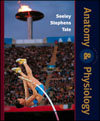 |  Houston CC: Anatomy & Physiology , 6/e Rod Seeley,
Idaho State University
Trent Stephens,
Idaho State University
Philip Tate,
Phoenix College
What's NewChanges to the Sixth Edition
The sixth edition of Anatomy and Physiology is the result of extensive analysis of the text and evaluation of input from anatomy and physiology instructors who conscientiously reviewed chapters during various stages of the revision. We have utilized the constructive comments provided by these professionals in our continuing efforts to enhance the strengths of the text.
Organizing Information in a Logical Sequence of Topics
In response to feedback from numerous instructors who teach anatomy and physiology, this edition has undergone the following carefully implemented organizational changes.
Past editions of the text presented the topics of resting membrane potentials, action potentials, and responses of receptor molecules in a separate chapter. For the sixth edition, we have moved these discussions closer to topics where knowledge of these concepts is essential. In the process, this material has been integrated into appropriate discussions within chapter 3 (the functions of cells), chapter 9 (muscle physiology), chapter 11 (nervous system physiology), and chapter 17 (endocrine system physiology). There is some repetition between the chapters on muscle function and nerve function, but the concepts are first outlined in a clear, but simple form, and then developed where more detailed knowledge is presented. The emphasis on the importance of understanding these concepts has in no way decreased.
Coverage of the nervous system has been reorganized, and a new chapter has been added. This reorganization aims to provide basic knowledge of nervous system structure and function, and then build on this foundation by incorporating thorough explanations of how the parts of the nervous system work together. The new sequence of chapters presents the basic organizational and functional characteristics of the nervous system (chapter 11), the structure and functions of the spinal cord and spinal nerves (chapter 12), the structure and functions of the brain and cranial nerves (chapter 13), and integrative functions of the nervous system in responding to sensory input and the generation of motor responses (new chapter 14). The chapters that describe the structure and functions of the special senses (chapter 15) and the autonomic nervous system (chapter 16) follow.
We have improved the clarity of some chapters by reorganizing concepts so they flow more readily and so that illustrations support the concepts developed in the text.
Visualizing the Relationship Between Structures and Functions
The artwork in the sixth edition has seen a major transformation. The following changes have been made to enhance the effectiveness of the illustrations in the text.
Continuing our increasing emphasis on coordinating the text and illustrations, many new Process Figures have been developed to provide well-organized, self-contained visual explanations of how physiological mechanisms work. These figures help students learn physiological processes by combining illustrations with parallel descriptions of the principal phases of each process.
We have modified nearly every figure in the text to reflect a more contemporary style and to make the colors and styles of structures in multiple figures consistent with one another throughout the book. The emphasis has been to make structures such as the plasma membrane, connective tissue, cartilage, and organs the same color, shape and style throughout the text. The resulting continuity between figures makes each structure readily identifiable so students can focus on understanding the concept the artwork intends to convey rather than having to first orient themselves to the surroundings depicted.
Homeostasis Figures have been redesigned and condensed to make it easier for students to trace the regulatory mechanisms involved in maintaining homeostasis. These simplified flow charts succinctly map out key homeostatic events, giving students a quick summary of complex mechanisms.
Building a Knowledge Base for Solving Problems
The problem-solving pedagogy of Anatomy and Physiology has been a defining characteristic since the first editions, and we have continued to improve this aspect of the text in the sixth edition. The infrastructure of pedagogical aids has been revised to round out a two-pronged approach to learning. Knowledge and comprehension level questions are balanced with questions that require more complex reasoning in both the narrative of the text and in the end-of-chapter exercises. The following features—some new, others carried over from previous editions—work together to deliver a comprehensive learning system.
Objectives have been grouped under the major headings in each chapter to briefly introduce students to the key concepts they are about to learn.
New review questions at the end of each major section encourage students to assess their understanding of the material they have read before proceeding to the next section. Answering these questions helps students evaluate whether they have met the objectives outlined at the beginning of the section.
Predict questions (many of them new to this edition) are carefully positioned throughout each chapter to prompt students to utilize newly learned concepts as they solve a problem. These critical thinking activities help students make the connection between basic facts and how those facts translate to broader applications.
The same hierarchy of knowledge-based and reasoning-based questions is repeated in the end-of-chapter exercises. New Review and Comprehension tests provide a battery of multiple-choice questions that cover all of the key points presented in the chapter for more recall practice.
The challenging Critical Thinking questions at the end of each chapter have been evaluated and, in some cases, expanded to help students develop the ability to use the information in the text to solve problems. Tackling questions of this level builds a working knowledge of anatomy and physiology and sharpens reasoning skills.
|
|



 2003 McGraw-Hill Higher Education
2003 McGraw-Hill Higher Education

 2003 McGraw-Hill Higher Education
2003 McGraw-Hill Higher Education